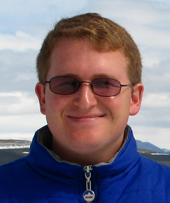Hello!
My name is Matt Niblett. I recently obtained my doctorate from UCSB in September 2014 and am currently a research affiliate in the geography department. The "nerdy stuff" I am interested in involves Spatial Analysis (optimization and statistics), location analysis, and GIScience techniques and methods, particularly where all three intersect environmental and human geographic problems. On the less nerdy side I like: building scale models, anything involving trains, planes, and automobiles, and being outdoors. I also enjoy cooking (particularly barbeque), playing board games (my latest favorite is Smash-Up), and enjoying the company of friends, where all or some of these interests intersect. The text below is a more formal biography.
Brief Biography
Dr. Matthew R. Niblett obtained his PhD in the Geography department at the University of California, Santa Barbara in September 2014, with emphases in: Operations Research methods involving spatial optimization & statistics, location analysis, and GIS. He obtained his MA in Geography at UCSB in March 2009 and his BS in Physical Geography from UCSB, graduating cum laude in June 2006. As an undergraduate, he undertook several independent research projects examining land use change in California's Central Valley. Additionally, he analyzed landsat imagery as a paid undergraduate research assistant to the late Dr. Leal A.K. Mertes. Furthermore, Dr. Niblett was a paid intern from June to October 2006 in Ventura County's Resource Management Agency - GIS division.
Dr. Niblett's dissertation examined dispersive location modeling. In particular, it focused on standards based dispersion, as modeled by the Anti-Covering Location Problem (ACLP). For example this could involve estimating carrying capacity of a territorial species or the configuration of retail stores that one might use to optimize profit considering competing locations. In his dissertation, he formulated a completely new conceptualization of the ACLP representing the lower bound, or least dense packing configuration - the "worst case" configuration. Moreover, he demonstrated that any existing ACLP model using a neighborhood constraint may have an upperbound that is at most 6. In addition, he developed a completely new ACLP formulation model, composed completely of clique constraints. The lower bound, or loose packing case, has never been considered in previous applied formulations of the ACLP. Dr. Niblett's dissertation shows that this case should be considered and that applied models using the ACLP may be overly optimistic when implemented. His dissertation committee consisted of Dr. Richard L. Church (chair), Dr. Stuart H. Sweeney, Dr. Keith C. Clarke and external member Dr. Tony H. Grubesic.
He conducted his master's thesis under the direction of Dr. Richard L. Church. His thesis involved developing and testing a logistics heuristic used to schedule fire fuels reduction activities for the United States Forest Service (iFASST & mFASST projects). He was a paid graduate student researcher on the iFASST & mFASST projects from July 2007 to June 2012. His previous work with US Forest Service personnel in forest ecosystem planning led him to work on an ecosystems planning research project from July 2012 to 2015 supported in part by the California Forestry Association.
Contact Information:
Department of Geography
1832 Ellison Hall
University of California, Santa Barbara
Santa Barbara, CA 93106-4060
E-mail: mniblett@geog.ucsb.edu
Office Location: 5th Floor of Ellison Hall
